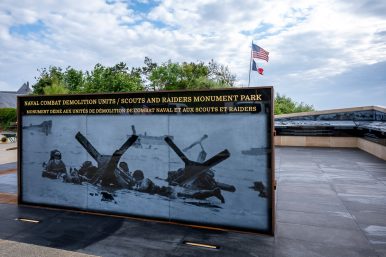Clark Nexsen contributes to SEALs D-Day monument
Virginia Beach company contracted for Omaha Beach monument

The U.S. Naval Combat Demolition Unit/Scouts and Raiders Monument Park is on Omaha Beach in Normandy, France. Photo by Andrew McLeish, courtesy Navy SEAL Museum.

The U.S. Naval Combat Demolition Unit/Scouts and Raiders Monument Park is on Omaha Beach in Normandy, France. Photo by Andrew McLeish, courtesy Navy SEAL Museum.
Clark Nexsen contributes to SEALs D-Day monument
Virginia Beach company contracted for Omaha Beach monument
Eighty years after the June 6, 1944, Allied invasion of Normandy, France, a Virginia company and other contractors gathered there to unveil a monument honoring the World War II predecessors of the Navy SEALs and special boat crews.
The Navy SEAL Museum San Diego, a museum opening late this year and a sister institution to the Navy SEAL Museum in Fort Pierce, Florida, contracted French and American companies to design and build the monument park in Normandy, which honors the Naval Combat Demolition Units (NCDUs) and Scouts and Raiders (S&R). The museum held an unveiling ceremony for the park on May 30, with about 250 people in attendance.
The memorial‘s dedication is one of several events happening in Normandy this week to commemorate the 80th anniversary, as President Joe Biden is in France to attend D-Day celebrations with surviving nonagenarian and centenarian veterans of the conflict that proved a critical turning point in World War II, leading to the liberation of France and the ultimate defeat of Nazi Germany.
Virginia Beach-based architecture, engineering and design firm Clark Nexsen collaborated on the SEAL monument’s design and provided landscape architecture, civil engineering, electrical design and some marketing materials, said Erin Horton, a senior landscape architect with Clark Nexsen who attended the unveiling ceremony. The company declined to disclose the contract’s financial value.
“The deadliest day in SEAL history was June 6, 1944,” said retired U.S. Navy Capt. Rick Woolard, chairman of the museum and a former SEAL, in a statement. “Our forefathers of the Naval Combat Demolition Units took devastating losses while clearing the beaches of Normandy so the troops could get ashore on D-Day. The museum is proud to honor the courage and sacrifice of the NCDUs and the Scouts and Raiders with a striking monument on Omaha Beach that will last for generations.”
The roughly 7,500-square-foot monument park is located about 600 yards away from the Normandy American Cemetery and Memorial, according to Horton and Matt Pearson, founding principal and architect with North Carolina-based Studio X Design. Pearson previously worked for Clark Nexsen.
After receiving the initial design, Clark Nexsen, Studio X and Laser Imaging and Design collaborated to further develop the monument’s design. “It became more of an interactive park, where people could walk through, sit on benches,” Horton said. “There’s a lot of different educational pieces that they could see and read about and it just became more of a park than just a monument or just a sculpture.”
The centerpiece of the monument is an original D-Day “hedgehog,” anti-tank obstacles resembling giant child’s toy jacks, made of three steel rails riveted together and used to block tanks and watercraft. NCDUs and Army combat engineers worked to demolish hedgehogs and other obstacles to clear gaps to the beach for Allied landing craft on D-Day. The Overlord Museum in France donated the hedgehog, according to a news release.
The hedgehog sits on a “living beach,” which is filled with sand from Omaha Beach and sand from other sites where NCDUs, S&Rs and SEALs fought, trained and died. During the ceremony, Woolard gave out 100 different sands from around the world, which contributors spread onto the beach, Pearson said.
A “living beach” is also a component of the Navy SEALs Monument in Virginia Beach, which Clark Nexsen completed in 2017 for the Florida-based Navy SEAL Museum. Horton and Pearson, then with Clark Nexsen, worked on the Virginia Beach monument together.
“The museum thinks it’s a very powerful piece that they wanted to incorporate into this monument as well,” Horton said. In addition to spreading sand during the unveiling, “this can continue in years to come as people visit the monument or there are ceremonies that are held in the future,” she added.
The monument park also has granite panels with etched scenes from Omaha Beach on D-Day, NCDU and S&R inscriptions in French and English and QR codes leading to webpages with more information. Additionally, the site features a map etched in granite identifying terrain and reference points on Omaha Beach that were key during the D-Day invasion, and a granite pillar sculpture of an NCDU demolitions expert in combat gear.

The project took about 20 months from idea to dedication, according to Horton.
She and Clark Nexsen have ties to the military that made work on this project meaningful for them.
“For Clark Nexsen, we’ve been living and working in Hampton Roads on a lot of different military projects for so long, we’ve established great connections with all walks of the military,” Horton said. “I’ve got military members in my family, so [I] kind of grew up in that environment. It’s very close to my heart.”
It’s also personally significant for Pearson, whose late grandfather landed at Utah Beach on D-Day, serving in the Navy and then later in the Army. Pearson’s grandfather told him he’d been able to hear the demolition units’ practice demolitions as they prepared for the invasion.
“There was a mission to do, and on June 6, 1944, they did it, and what we’re doing is just honoring what they did on that day,” Pearson said.
Pendleton S. Clark founded Clark Nexsen in Lynchburg in 1920. The company has around 175 employees based in its Virginia Beach headquarters and about 315 employees total. Clark Nexsen has four offices in Virginia, three in North Carolina, one in Georgia and one in Tennessee.
Here in Virginia, the National D-Day Memorial Foundation and Virginia Tech are working to broaden the National D-Day Memorial, adding an audiovisual production for the 80th anniversary ceremonies. The memorial opened in 2001 in Bedford, chosen because Bedford lost 20 residents in the invasion, making it the U.S. community that suffered the highest known per capita losses on D-Day.
Virginia Tech’s Institute for Creativity, Arts, and Technology and the foundation wrote and created the 25-minute projection show that includes firsthand accounts of the invasion.
T

















